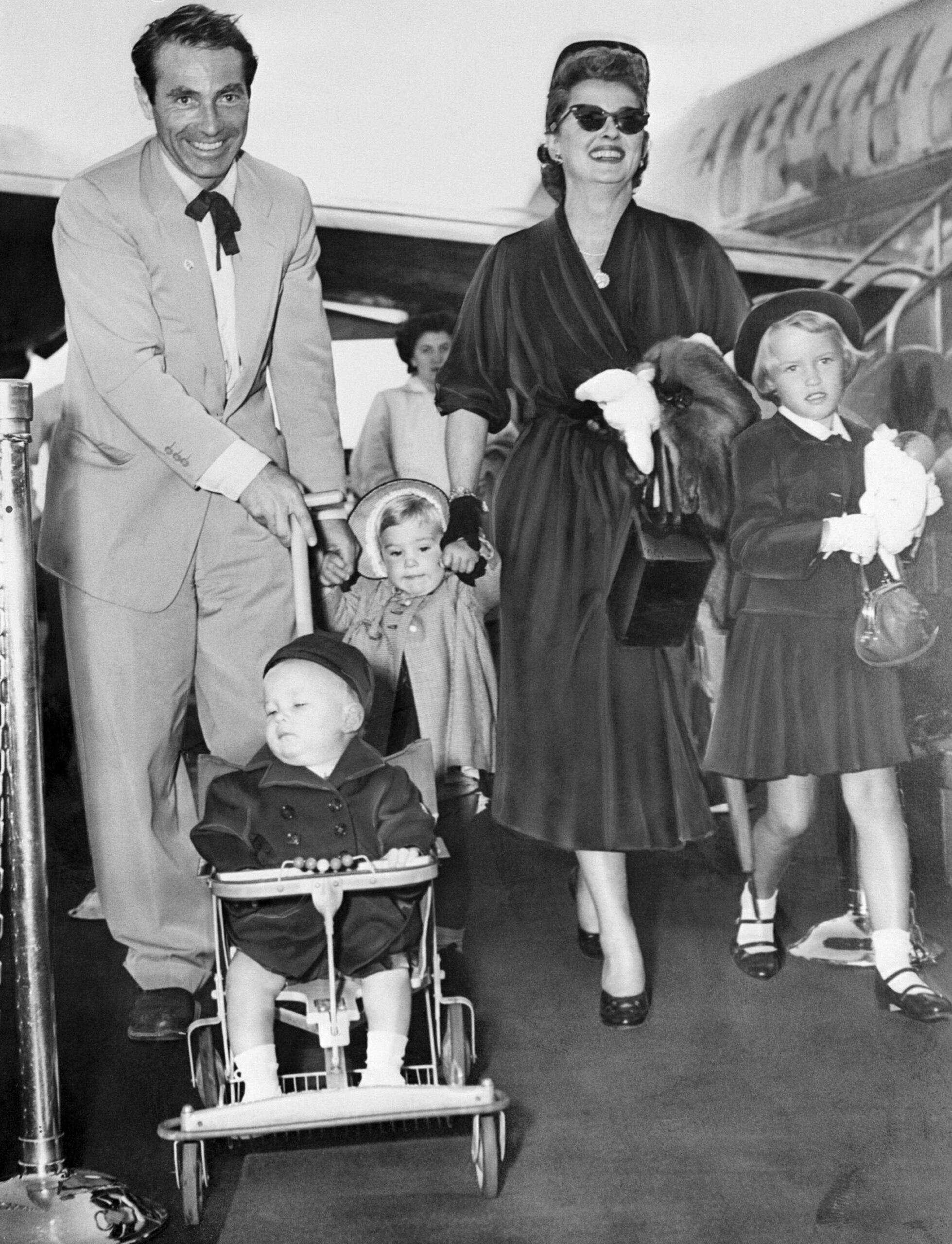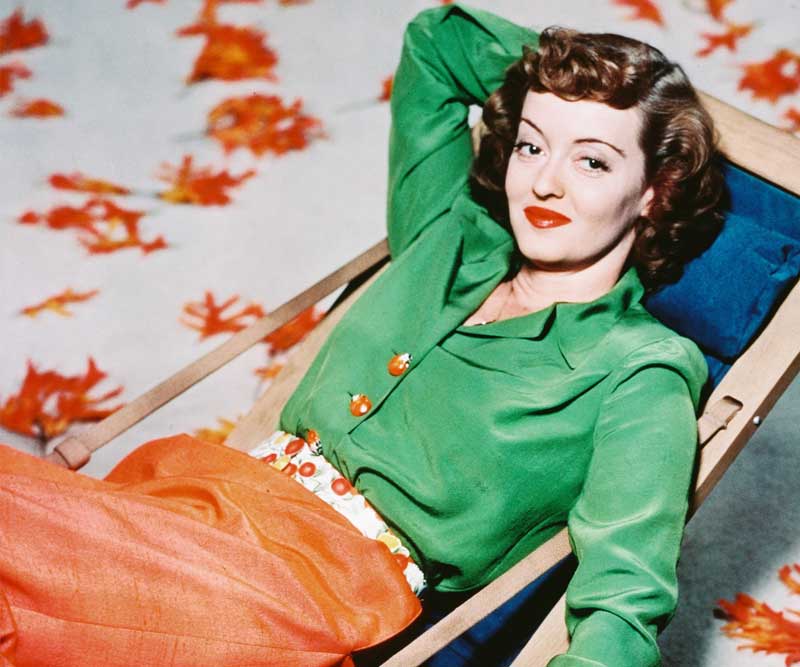She was the first person to receive 10 Academy Award nominations and she twice won for Best Actress. The first woman to receive a Lifetime Achievement Award from the American Film Institute, and the first female president of the Academy of Motion Picture Arts and Sciences, Bette Davis is engraved in history as one of the most accomplished female actresses of classic Hollywood history.
Known for her willingness to play unsympathetic characters, when she died from breast cancer in 1989, the world lost one of the last of the greats.
Entering the living room of Kathryn Sermak, Bette Davis’ personal assistant of 10 years, you are immediately transported back to old Hollywood. Dominating the room is the actress’ striped chaise longue, like a long throne and draped in a fur wrap, as if Bette has only just left the room for a few minutes to light one of her 100-a-day cigarettes.

Bette Davis and Kathryn Sermak in 1987.
The dresser holds her collection of crockery: winter serving dishes featuring animals; summer dishes, a welcoming house in blue. There are Thanksgiving dining plates on which a large turkey dominates, and a gravy boat big enough to serve a squadron.
The exquisite ruby water glasses are as big as vases and as heavy as small gym weights; the wine goblets are elegant creations of a bygone age. Bette’s pride in the appearance of her dining table is not what one might expect from a woman who played an ageing former actress, holding her paraplegic sister captive in What Ever Happened to Baby Jane?.
Kathryn Sermak’s new book, Miss D & Me, reveals even more, with its anecdotes and insights into Bette Davis’ life on the other side of the camera. It is also a tribute to the woman she acknowledges taught her everything when she started out as a naive Catholic 22-year-old working for one of the world’s greatest movie stars.
When we sit down to talk at Bette’s dining table and sip rosé from the classic glasses, it’s impossible not to feel a sense of her presence.

Bette at home in her Beverly Hills house in 1988, the year before she died.
To Kathryn, Bette always be Miss D. The name stuck when Catherine (as she was then) found addressing her employer by her first name too familiar. Bette, who had changed the spelling of her name, encouraged Catherine to do the same.
“I want to advise you that one of the big battles in life is to stand out from the crowd,” she said. Hence, in 1979, Miss D and Kathryn, the double act, was born.
“I didn’t know who Miss D was,” says Kathryn.
The night before the job interview, she read Bette’s autobiography, The Lonely Life, in which the actress spoke of her need for perfection, even as a child.
“She was very focused on details and when she went to the circus as a young girl, the elephants were walking down this carpet to the ring and the carpet was misaligned. She couldn’t focus on the performance because the carpet infuriated her.”
It was an attention to detail Kathryn had witnessed in her photographer father and would stand her in good stead for the job she landed with the then 71-year-old. She assured Bette she could cook the three-minute egg she required every morning, and told her she knew nothing about the film industry.

Bette and her daughter Barbara in the mid-1960s. Barbara’s “betrayal” broke Bette’s heart, Kathryn says.
“That’s good,” said Bette, “I will teach you everything you need to [know].”
“Suddenly, I was in a limousine, and I’d never been in a limousine. I was on Concorde, and I’m looking at her and thinking, ‘Who are you, Grandma, in your really red bows!’
“She really did teach me everything – so much that helped me then, and continues to now. Discretion, respect. She was the most honest, respectful person, big time. It didn’t matter if you were the elevator person, she would greet them all. Always respect, she said. Everybody has a job to do. You’re no higher or lower. Your fans are your bread and butter, the ones who pay the money to go to your movies. I learned so much after she passed because now I’m seeing what everyone thought – ‘Oh, she must have been so difficult.’ If she was that difficult I wouldn’t have been with her for 10 years.”
The recent TV series Feud painted a picture of a more difficult character in the actress’ rivalry with Joan Crawford.

Bette with Joan Crawford in 1962.
It is a picture Kathryn does not recognise.
“Feud is Feud. It’s entertaining; it’s not accuracy. Miss D was always the first to admit when she was wrong. That’s what a strong person does. She was a woman in a man’s world [her smoking and drinking are legendary] and when men are strong and confident, you give them respect, but if you are a woman, you get the big ‘No’. But she had confidence – that’s why all her attorneys left, because she caught everything. And she had the studio system.
“She taught me about women – yes, they are cat-fighting, but you bond together. She loved men, absolutely, but she was supportive of women.”
Married four times, men were a big part of her life and, says Kathryn, “she was happiest when she was in love. When she was in love, look at her films, especially when she was in love with Willy Wyler.”

With husband Gary Merrill and their three children.
Bette had an affair with Wyler when he directed her in Jezebel (for which Bette won one of her two Oscars; the other was for Dangerous).
“He was everything I dreamed of in a man,” she said.
“Love and passion soon followed.”
His view was she was “passionate and emotional, with more energy than anyone I’d ever known. Too much for me.”
Of her last husband, Gary Merrill, Bette said: “Gary was macho but none of my husbands was ever man enough to become Mr Bette Davis.”
Relationships and her abortions (she is said to have had three – one as a result of her affair with Wyler) were not something Bette discussed with her ingénue assistant, although Kathryn learned about men from her employer.

With one of her great loves, director William Wyler.
“I didn’t know much about them and she talked me through the stages of having boyfriends. She certainly helped me with Pierre [one significant other] and his messiness. Miss D hated mess. ‘Just move it on the floor,'” she advised.
It became a competition between Pierre and Miss D for Kathryn, and it was clear Pierre stood no chance.
The most difficult man in Bette’s life was son-in-law Jeremy, married to her biological daughter, Barbara, known as B.D. (Bette also adopted children: Michael and Margot with Gary.)
They met when B.D. was 15 and he was 29, when he was her chaperone at the Cannes Film Festival. Jeremy was the British nephew of American film executive Eliot Hyman.

Bette Davis as a Hollywood belle.
“Miss D was being escorted by the director Robert Altman – who, by the way, she never had an affair with, as they insinuated in Feud – and she needed an escort for her daughter. Jeremy went to pick up B.D., who
was tall, slender and very striking, and she fell in love with her handsome companion.”
They wanted to get married, but B.D. needed her parents’ consent. Bette refused to give it, “so B.D. threatened her: if you don’t give it, we’re going to elope. Miss D always blamed herself that she never gave B.D. a proper father.”
Central to the book is a family reunion for July 4 Independence Day celebrations, when tensions reached a head between Bette and Jeremy. It had been a huge operation, with Bette and Kathryn preparing to make sure everything would be perfect for the arrival of the family for the holiday in a house in Huntington Bay.
“We worked our buns off for two weeks, planting things, repairing the fence; Miss D even bought a dishwasher and added fumigators. She spared nothing for her family because she loved them so much.” In an argument about whether there are clams in the Bay, the two personalities clashed.

On the arm of Henry Fonda in Jezebel, for which she won an Oscar.
B.D. subsequently wrote two scathing books about her mother, and it’s clear Kathryn was no fan of Jeremy’s.
“Jeremy once came to the Colony House for dinner and told me, ‘I could have married the richest girl,’ and I thought, ‘Well, you didn’t do so badly.’ I saw Miss D paid for a lot and helped them out financially, but when she had her stroke, following her breast cancer diagnosis, Harold [the attorney] told him that legally Bette could not bail him out of bankruptcy again as she was on medication.”
This, says Kathryn, was the most painful time emotionally.
“There was the horror she’d never act again, and she loved acting. Her agent said she should never be seen again and go off, like Greta Garbo. I said, ‘Are you kidding?’ I thought, ‘She’s given everything and now you’re saying put her out to pasture because she didn’t look too well.’ I knew her spirit and her strength, but it was a difficult four months. It’s like being a baby – you’ve got to learn to walk and talk again. She thought she wanted to die, so I exploded: ‘If you want to die, go ahead, or we’re going to fight this together.'”

Bette Davis – with Kathryn by her side – is mobbed by fans in London’s Piccadilly after the launch of her autobiography in 1987.
B.D. attended once, despite Bette having sent a limo six hours away to pick her up.
“Miss D was so happy and B.D. wouldn’t even stay one night. I have the letters she wrote, the photos, she talked to her mom all the time. Then, a year later, I heard about B.D.’s book and I thought, ‘Aha!'”
The book, My Mother’s Keeper, was an enormous shock to Bette.
“The betrayal – that was worse than the stroke. Miss D was completely blindsided by it. That’s what killed her – a broken heart. She loved B.D. more than anything. She loved her adopted children and treated everybody fairly, but there was that mother connection with B.D. There’s no question she and Jeremy didn’t see eye to eye, but she knew B.D. had married him and when she went to their farm she’d take lobster and artichokes, which they loved. Miss D gave to you – she gave her daughter a lake. I once asked her, ‘How did you give your daughter a lake?’ and she said: ‘[A lake of] money.'”
The perception of Bette is that although brilliant, she was a lonely, irascible woman. Nothing could be further from the truth, says Kathryn. “She loved reading, especially autobiographies, and had many friends. She loved cooking. People misinterpreted The Lonely Life. She said, ‘It’s like any writer, any artist – it’s you and only you up on that screen or that blank page. It doesn’t mean your life is lonely.’ She was always busy, always had friends – Laurence Olivier, Robert Wagner, Roddy McDowall.”

The Hollywood star at the height of her glamour, circa 1940.
When Bette died in 1989 it was the end an era for Kathryn, then aged 33, as well as the film world.
“No one prepares you. You lose your best friend, which is very, very painful; you lose your job, the place where you live; you lose your identity.” But she didn’t grieve.
“You cannot. I knew who Miss D was. I had a job to do and there was no time to be emotional. I had the press; I had to organise things. You have to put the grieving process on the back burner.”
Miss D would not, says Kathryn, have liked today’s Hollywood.
“She wouldn’t approve. She knew she and that world were going. In came animation – it was just different times. But I don’t think she was glad to be going, as she had so much fun.”
I leave the house as if I’ve been in the presence of the great legend herself. When I look at the photos of the plates on my iPhone, there’s a video of an arm serving food. How it got there, I have no idea, it’s a bit spooky. That’s the magic of Hollywood, I suppose.
Miss D & Me by Kathryn Sermak (Hachette) is on sale now, RRP $44.99.


-scaled.jpg)